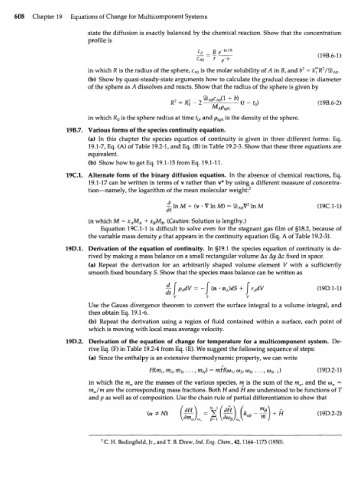Page 628 - Bird R.B. Transport phenomena
P. 628
608 Chapter 19 Equations of Change for Multicomponent Systems
state the diffusion is exactly balanced by the chemical reaction. Show that the concentration
profile is
= Yr
7 c A0 г е -ь
2
2
in which R is the radius of the sphere, c is the molar solubility of A in B, and b = k"'R /^ ,
A0 AB
(b) Show by quasi-steady-state arguments how to calculate the gradual decrease in diameter
of the sphere as A dissolves and reacts. Show that the radius of the sphere is given by
2
= R 0 -2 b) <f - t 0 ) (19B.6-2)
in which R is the sphere radius at time f 0/ and p sp h is the density of the sphere.
o
19B.7. Various forms of the species continuity equation.
(a) In this chapter the species equation of continuity is given in three different forms: Eq.
19.1-7, Eq. (A) of Table 19.2-1, and Eq. (B) in Table 19.2-3. Show that these three equations are
equivalent.
(b) Show how to get Eq. 19.1-15 from Eq. 19.1-11.
19C.1. Alternate form of the binary diffusion equation. In the absence of chemical reactions, Eq.
19.1-17 can be written in terms of v rather than v* by using a different measure of concentra-
tion—namely, the logarithm of the mean molecular weight: 2
4: In M + (v • V In M) = <$ V 2 In M (19C.1-1)
ot AB
in which M = x M A + x M . (Caution: Solution is lengthy.)
B
A
B
Equation 19C.1-1 is difficult to solve even for the stagnant gas film of §18.2, because of
the variable mass density p that appears in the continuity equation (Eq. A of Table 19.2-3).
19D.1. Derivation of the equation of continuity. In §19.1 the species equation of continuity is de-
rived by making a mass balance on a small rectangular volume Ax Ay Az fixed in space.
(a) Repeat the derivation for an arbitrarily shaped volume element V with a sufficiently
smooth fixed boundary S. Show that the species mass balance can be written as
n
j j p dV = - J (n • )dS + j r dV (19D.1-1)
t A A A
V S V
Use the Gauss divergence theorem to convert the surface integral to a volume integral, and
then obtain Eq. 19.1-6.
(b) Repeat the derivation using a region of fluid contained within a surface, each point of
which is moving with local mass average velocity.
19D.2. Derivation of the equation of change for temperature for a multicomponent system. De-
rive Eq. (F) in Table 19.2-4 from Eq. (E). We suggest the following sequence of steps:
(a) Since the enthalpy is an extensive thermodynamic property, we can write
m 2 , m 3 ,..., m N ) = <о 2 , co 3 ,..., о^м) (19D.2-1)
H(m u mH(a> u
in which the m are the masses of the various species, m is the sum of the m , and the a) =
Q a a
m /m are the corresponding mass fractions. Both H and H are understood to be functions of T
Q
and p as well as of composition. Use the chain rule of partial differentiation to show that
С. H. Bedingfield, Jr., and Т. В. Drew, lnd. Eng. Chem., 42,1164-1173 (1950).
2

